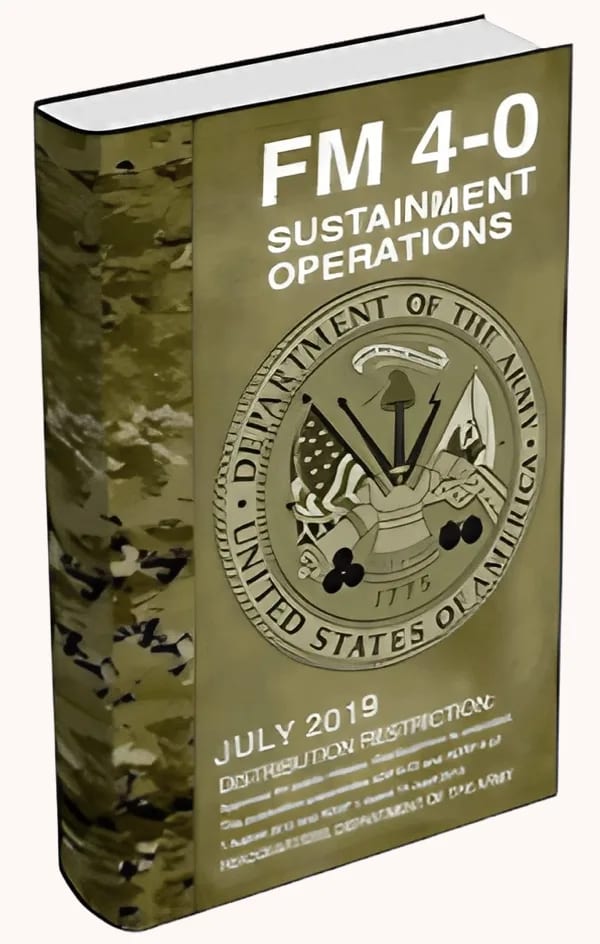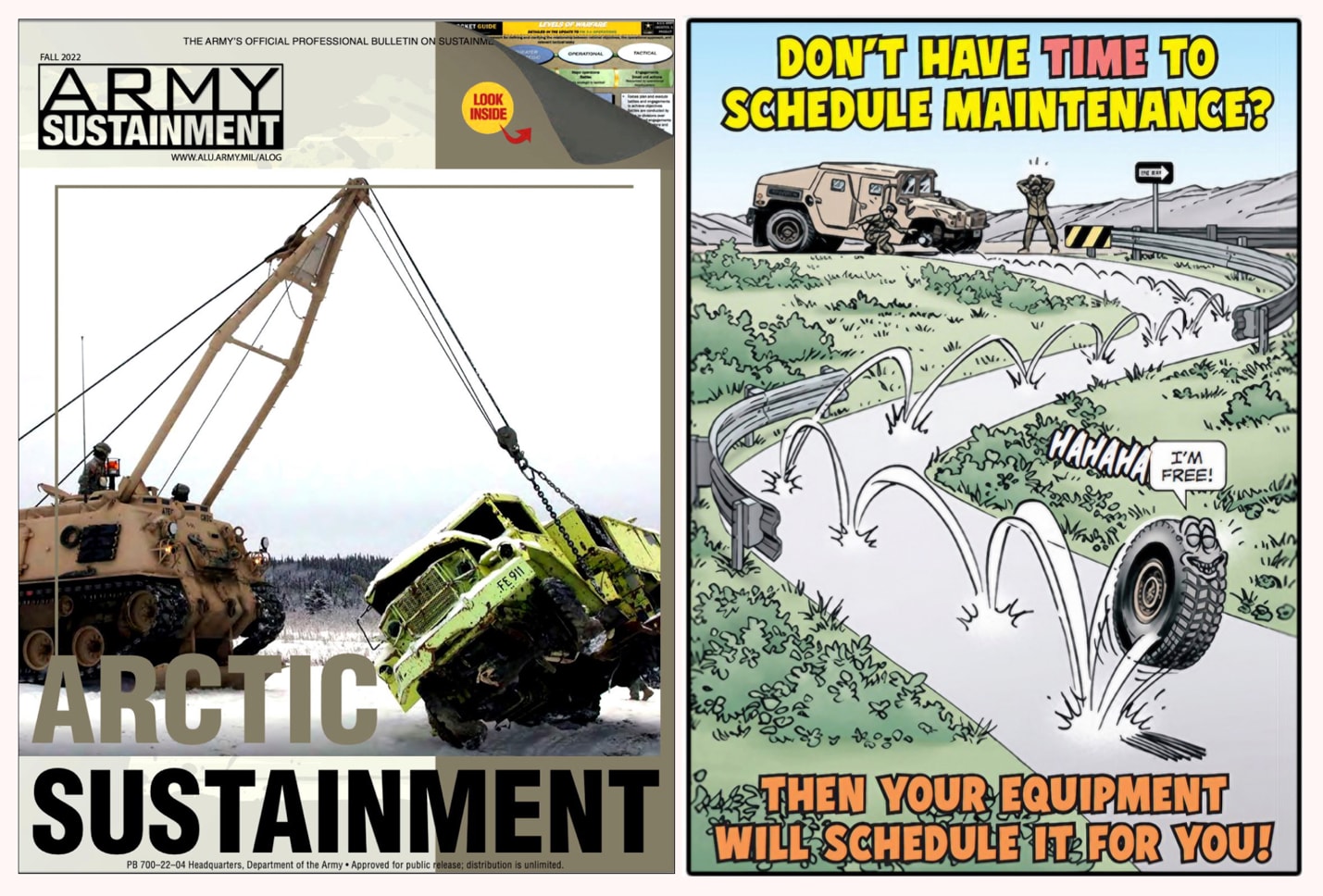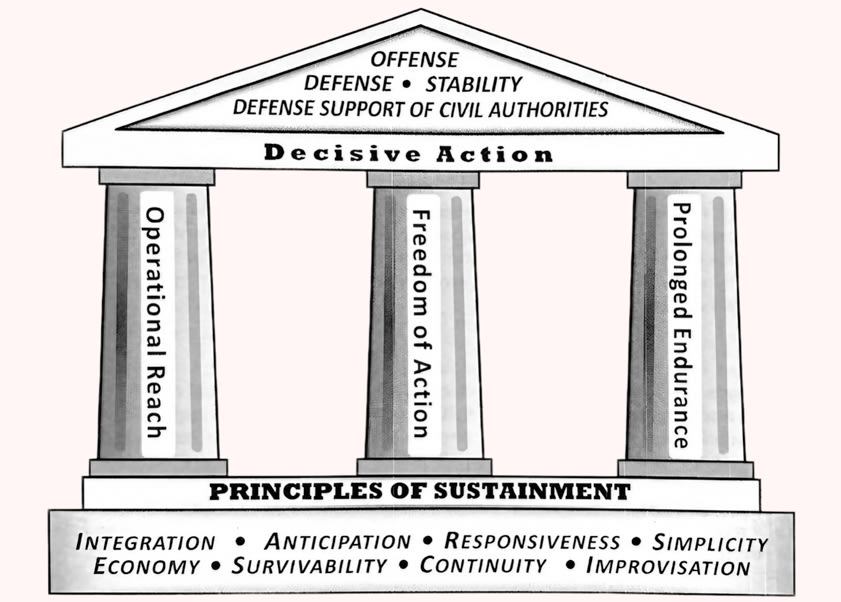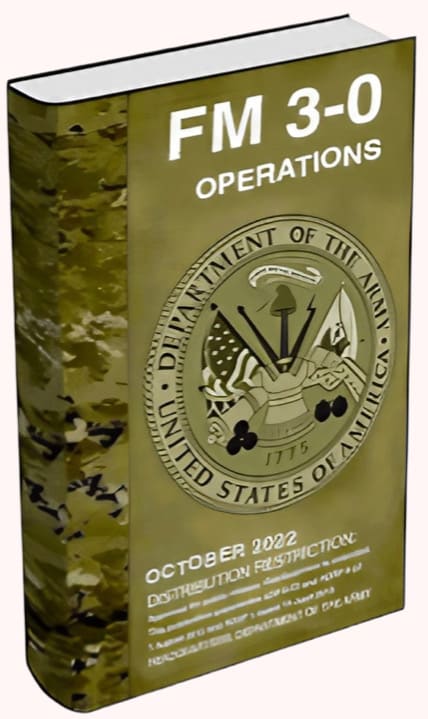Digression 4 - SUSTAINMENT - The Concept

WWHO STUDIES, TESTS, AND INSTITUTIONALIZES MAINTENANCE-MIND BEST? I find that the most active frontiers of maintenance theory and practice are in four domains: manufacturing, aerospace, software—and the military.
The US Army, lately, has introduced a new term—“sustainment”— signaling a seismic shift in its doctrine. It was formally introduced in 2009 with a new edition of Field Manual 4-0, previously titled Combat Service Support. The new FM 4-0 was titled Sustainment Operations. For the Army, the manual has the semi-Bibilical status of a “doctrinal publication”—meaning that it spells out official principles, guidance, and best practices. The 2019 edition defines the subject this way: “Sustainment is the provision of logistics, financial management, personnel services, and health service support necessary to maintain operations until successful mission completion.”1

An Army magazine on logistics was renamed Army Sustainment in 2009. This 2022 cover shows the M88 Armored Recovery Vehicle (ARV) hoisting a truck out of trouble. The Army built a thousand M88s for “battlefield rescue and recovery,” especially in support of tanks. Meanwhile, the magazine founded by Will Eisner in 1951, PS: the Army’s Preventive Maintenance Magazine, continues to be published monthly, often illustrated with comic-book art like on the right.

The US Army’s new doctrine portrayed in institutional mode—as sound as a bank, as informative as a library—with signifying words and catchphrases shown in architectural relationship. The illustration and the concept point toward the crucial outcome—Decisive Action.
That sounds like no more than a bureaucratic nuance, but it is a major redirection for the military. Some of the supporting concepts are particularly interesting. The stated goal is “Decisive Action,” achieved by “Operational Reach,” “Freedom of Action,” and “Prolonged Endurance”—also referred to as “unrelenting endurance.” Sustainment never lets up.
The manual describes what is meant by “Freedom of Action”:
Sustainers enable freedom of action by… proper application of the mission command philosophy… which encourages the greatest possible freedom of action from subordinates…. It equips subordinate commanders with the authority and flexibility to act boldly and achieve desired support effects in the absence of continuous direction from higher headquarters.2The principle of “mission command” (as distinct from “detailed command”) is a profound improvement on how I was trained as a young Army lieutenant in 1961. My instructors said that American soldiers won’t follow orders they think are meaningless; they insist on knowing why a particular mission is important. That’s fine, but it’s just about motivation. Mission command goes way beyond that to distributed empowerment. A paper on the subject says this: “Mission command… provides the means through commander’s intent, mission-type orders, and decentralized execution to operate at the speed of the problem.” It quotes General George Patton: “Never tell people how to do things. Tell them what to do and they will surprise you with their ingenuity.”3
The idea has a rich history. On October 14, 1806, the fabled Prussian army was vanquished on two battlefields simultaneously by Napoleon’s forces. In a 2005 paper titled “The Road to Mission Command,” Stephen Bungay explains how it happened:
Napoleon introduced mini-armies called Corps, containing a balance of infantry, cavalry and artillery, and so able to operate independently of each other. Each was commanded by a Marshal, a man picked on merit by Napoleon himself. In conducting the campaign, Napoleon was able to communicate very rapidly with the Marshals because they shared a basic operating doctrine, and he explained his intentions as well as what he wanted them to do. He expected them to use their initiative and act without orders in line with his intentions. They did. The result was an operational tempo which left the incredulous Prussians bewildered.4Stung by the humiliation, the Prussian military studied how Napoleon had beat them and created their own doctrine of decentralized command called “Auftragstaktik”—“mission-based tactics.” The doctrine stated that “Senior commanders should ‘not order more than is absolutely necessary’ but should ensure that the goal was clear. In case of doubt, subordinate commanders should seize the initiative.”5 The next time the Prussian and French armies met on the battlefield, in the Franco-Prussian War of 1870, the French commanders had forgotten Napoleon’s practice and were defeated by commanders who had studied and improved it.
When Prussia followed up its victory by launching the highly militarized German Empire, Auftragstaktik was the core philosophy for training its officer corps. They were taught that the army that could act and react with the greatest speed would prevail in battle. They were taught to expect chaos on the battlefield and to take charge of it. Chaos that they created would be transparent to them while it blinded the enemy. Since trust between levels of command was essential, “all NCO’s were trained as officers and officers were expected to master the tasks of two ranks higher up the hierarchy and to take their place if needs be.”6
As a result, Nazi Germany’s Wehrmacht was the ablest military force in the Second World War. A 1977 study by US Army Colonel Trevor Dupuy declared:
On a man for man basis, the German ground soldier consistently inflicted casualties at about a 50% higher rate than they incurred from the opposing British and American troops under all circumstances. This was true when they were attacking and when they were defending, when they had a local numerical superiority and when, as was usually the case, they were outnumbered, when they had air superiority and when they did not, when they won and when they lost.7In 1977, the American military was figuring out how to recover from Vietnam—a conflict it had lost despite—or perhaps partly because of—a combination of superb communications and data collection and complete air superiority, all of which intensified top-down control. It had got to the point that Commander in Chief Lyndon Johnson was selecting bombing targets. The search for a better theory of battlefield command led to investigation of the Wehrmacht’s “Auftragstaktik“ and its eventual translation into Yank—“mission command.”

“”Mission command” stars in the new editions of The US Army’s 362-page Field Manual 3-0, which expounds “the fundamental principles and overarching doctrinal guidance for conducting operations,”and “applies to all members of the Army Profession.”
The idea took hold formally in 2010, when mission command was made part of official Army doctrine in Field Manual 3-0 - Operations. It directs that:
Commanders focus their orders on the purpose of an operation rather than on the details of how to perform assigned tasks. Doing this minimizes detailed control and allows subordinates the greatest possible freedom of action.16Sustainment providers in particular are now expected to be able to act without direct orders in support of whatever unit they are responsible for. In a combat situation, they must not wait for a supported commander to tell them, “I need ammunition (or fuel, or food, or repair, or medical help) NOW.” They have to understand the commander’s intent well enough to anticipate the needs of the supported unit and, on their own initiative, keep the right support flowing to the right places at the right time. When speed is essential and information is limited, sustainers understand that “a decent plan carried out immediately is superior to a superb plan carried out much later.”8
Fundamental to all of this is maintenance. The operators and crew of a weapons system, vehicle, or other equipment are encouraged to assume ownership of their machine and take pride in how well they can make it perform. Their manuals declare: “Operator/crew maintenance is the most critical operation of the Army maintenance system. Preventive maintenance checks and services (PMCS) is the foundation of field level maintenance.”9
Some of the maintenance training is so specialized that commanders worry about the requisite skills being “one deep” in the crew, and so “the commander must ensure that multiple individuals are cross-trained and cross-supportive.”10 (Cross-training was a decisive element in the October War of 1973. What would happen if a tank’s gunner was incapacitated? That would put the tank out of action for the Egyptians because the gunner’s skills were jealously concealed from everyone else. With the Israelis, every tank commander had been trained as a fully qualified gunner and thus could see the battlefield with a gunner’s eye, direct the tank accordingly, and also aim and fire the gun if necessary.) Cross-training builds mutual respect and sharp teamwork, and it makes training lively when team members’ roles are suddenly swapped.
For weapons systems in combat, where hard use and battle damage can take a weapon down, the focus is “on returning systems to operational status as quickly and as near as possible to the point of failure or damage.”11 On the battlefield, units of Ordnance-School-trained maintainers with specialized tools and skills are deployed as far “forward” as possible to back up the combat units. The combat crews are trained “to move the [damaged] vehicle at least one terrain feature or one kilometer away from enemy contact”12 and to recognize the “distinct colors and odors” of leaking fluids to help the Ordnance specialists diagnose problems. Battle damage and repair (called BDAR) emphasizes expediency. One manual spells it out:
BDAR is accomplished by bypassing components or safety devices, cannibalizing parts from like or lower-priority equipment, fabricating repair parts, jury-rigging, taking shortcuts to standard maintenance, and using substitute fluids, materials or components. Depending on the repairs required and the amount of time available, repairs may or may not return the vehicle to a fully mission-capable status.13In other words, do whatever is necessary to get the system back in action. The acronym ASAP for “As Soon As Possible” was invented by the military.
The idea of sustainment has uses far beyond the realm of the military, and happily there is a good book published in 2023 that expands the concept and formalizes it. Its title is System Sustainment: Acquisition and Engineering Processes for the Sustainment of Critical and Legacy Systems, by Peter Sanborn and William Lucyshyn. On the broader applications of sustainment, they write the following:
“Sustainment” (as commonly defined by industry and government), is comprised of maintenance, support, and upgrade practices that maintain or improve the performance of a system and maximize the availability of goods and services while minimizing their cost and footprint or, more simply, the capacity of a system to endure. System sustainment is a multi-trillion-dollar enterprise, in government (infrastructure and defense) and industry (transportation, industrial controls, data centers, energy generation and others)…. We refer to these as “critical systems.”… These systems are rarely adequately resourced for their long-term sustainment, and even when they are, the sustainment budgets are the first thing raided when funds are needed for other more pressing matters…. One defining attribute of sustainment-dominated systems is that they always end up having to be supported longer than anyone anticipated…. The title of this book could have been “support of legacy systems.”The most common modern synonym for sustain is maintain. Sustain and maintain may be used interchangeably, however, maintaining most often refers to actions taken to correct or avoid problems, while sustaining is a more general strategic term referring to the management of the evolution of a system…. “Repair” represents a subset of maintenance activities that occurs after a failure. Maintenance includes repair, but also activities associated with keeping the system from failing.14Sustainment, then, is seen as embracing a larger time frame than maintenance, and it supports system evolution. A worrying condition worldwide is that civilization’s critical systems are rarely adequately resourced for long-term sustainment. The authors draw attention to the related concept of “sustainability:”
The best-known socio-ecological definition of sustainability (attributed to the 1987 “Brundtland Report”), is commonly paraphrased as “development that meets the needs of present generations without compromising the ability of future generations to meet their own needs”.15The distinction is that “sustainability” is merely a goal, whereas “sustainment” is a plan, a program, a set of actions. The one says “Aspire;” the other says “Here’s how to get it done.”
And keep it done. "Unrelenting endurance" is the commitment.
Charles C. Mann, a science journalist, expands on the distinction. He wrote me:
“Sustainability" has become, all too often, a vaguely invoked goal of reaching some steady-state situation in the indefinite future. “Sustainment” calls for a course of present-day action, iterative and constantly adjusted.He’s right to emphasize iteration. It means the sustainment process never stops learning, and that’s inviting. Also the process can, if necessary, start small and uncertain, find its way, and scale up or pivot as needed. “Sustainability” tells almost nothing about how to begin. “Sustainment” says, “Get to work.”
The sustainment concept might help us think pragmatically about humanity’s role in taking increasing responsibility for the health of our largest and oldest legacy system, Earth’s biosphere. I will come back to these matters in my System Repair chapter, the infrastructure part of the Cities chapter, the Software chapter, and the Planet chapter.
_____________
(This is the 2nd segment of 3 in the SUSTAINMENT Digression. “1973, Israel Maintains” is the first segment. The next segment is“2022, Ukraine Maintains.”)